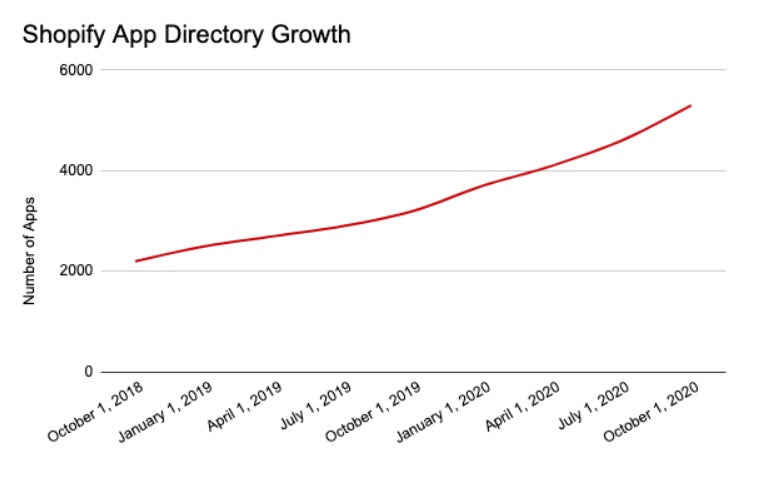If you don’t know your client or user base, you’re less likely to offer something they want or need. You may have already conducted focus groups or user research, but big-picture app development and business trends can vary wildly based on factors beyond your target market’s control.
We recently covered some of the technical app trends we expect to see in 2021. In this article, we asked some of Shopify’s leading partnerships, developer success, and senior business development managers to share:
- The app development business trends they see coming over the next 12 months
- What impacts these trends will have on merchants, and
- How app developers can make the most of these opportunities or challenges
Whether you’re looking to build your first—or next—Shopify app, here are nine trends you’ll want to keep in mind throughout 2021.
1. Bridging the marketing gap with smart technology and small teams is essential
Brian Peters, Strategic Partnerships Manager, Plus Technology Partnerships
Year-over-year, one of the biggest challenges for Shopify merchants is marketing. From brand building and influencer marketing, to advertising and generating traffic, effective marketing remains a critical strategy for growth. Luckily for brands, we continue to see marketing technologies emerge that help merchants make better marketing decisions across the entire marketing funnel.
Marketing automation platforms are truly starting to bridge the gap between technology and human creativity, allowing merchants to make smarter marketing decisions. This starts with understanding customers on a deep, personal level, and connecting the dots across channels and touchpoints.
Marketing automation platforms are truly starting to bridge the gap between technology and human creativity, allowing merchants to make smarter marketing decisions.
Once merchants have a clear picture of who their customers are (and who their future customers are likely to be), they can begin to implement much more sophisticated marketing workflows that are tailored to what the customer is most likely to interact with—and where.
We’re going to see a lot more sophisticated marketing strategies employed by merchants with small marketing teams and budgets given the impressive marketing technology landscape developing in the Shopify app ecosystem.
Developers and organizations building for Shopify merchants should expect merchants to continue to push the boundaries of marketing with strategies like SMS, video, influencers and affiliates, and live selling, while also continuing to master proven channels such as email, user generated content, and even direct mail. The opportunities to build cross-channel technologies in those spaces remains abundant as merchants look to gain a competitive marketing edge.
2. This is the decade of cross-platform app proliferation
Riley Zammit, Developer Success Manager

The number of devices consumers own is increasing, and so the need for apps to have a presence on multiple platforms is growing too. In 2021 and beyond, app developers are projected to increase their use of cross-platform frameworks like React Native and Flutter to get their products to market on multiple platforms quickly and cheaply.
React Native has seen downloads increase from 50,000 per week in 2017 to almost 500,000 per week and has 98,000 stars on GitHub. Flutter has accrued 111,000 stars on GitHub since its launch in 2017, indicating extremely high interest though it is relatively new to the market.
As the community of users grows, these frameworks will continue to mature, enabling better performance and native functionality on platforms like Apple Watch, Apple TV, native Windows, and native Mac.
It’s likely in 2021 that we’ll also see a rise in the importance of UX specialists driven by the increasing ubiquity of cross-platform apps.
It’s likely in 2021 that we’ll also see a rise in the importance of user experience (UX) specialists driven by the increasing ubiquity of cross-platform apps. Maintaining a good user experience across platforms is likely to remain a challenge for two reasons:
- The explosion in website builder tools is largely responsible for the good design and UX that is now the default on the web, and analogous tools don’t yet exist for cross-platform technology.
- Developers and product designers will need to consider the variance in devices they need to support. Think of the difference in screen size and user context between a laptop and an Apple Watch.
App developers that can get comfortable with building for multiple platforms while maintaining a high-quality UX are more likely to build a successful, long-term app business.
You might also like: 11 Ecommerce Trends You Need to Turn Your Attention to in 2021.
3. A major evolution of “live shopping” is happening now
Hooman Mehranvar, Senior Business Development Manager
One trend that accelerated during COVID-19 has been the growth of live shopping, which is the evolution of live, call-in shopping television networks that swept North America and the world in the 1970s and 1980s. With consumers increasingly making purchases from their homes, merchants are looking for ways to bring their products to life and have more personal interactions with their customers.
This modern take on the Home Shopping Network and QVC (Quality Value Convenience) TV channels is already a multi-billion dollar industry in China and poised for continued global growth. Popular consumer platforms are already investing in this trend—Shopify and TikTok officially partnered last year to create in-feed shoppable ads for merchants and video creators alike.
Retailers with engaged audiences are beginning to experiment with live selling on their own websites and social media accounts so they look to engage their audiences in a much more interactive format.
Merchants are increasingly looking for technology solutions, like apps, that will enable them to run their own live shopping experiences, so they can take advantage of this shopping trend and attract new customers. They’ll be looking for solutions that improve interactions with customers and make the checkout experience seamless.
4. Supply chain diversification is important
Mario Ranasuriya, Strategic Partnerships Manager
One of the greatest challenges merchants face as a result of the pandemic is supply chain disruption. Merchants have had difficulty communicating with suppliers, and have experienced shortages and delays in overseas production and fulfillment. These challenges were especially prevalent for brands that sourced products (or raw materials) from China, which, aside from the pandemic, also struggled with geopolitical tensions.
One of the greatest challenges merchants face as a result of the pandemic is supply chain disruption.
Travel bans and social distancing have also restricted merchants from sourcing products through traditional means, such as trade shows and manufacturing site visits. Merchants have been unable to assess the quality of products through physical samples, or the quality of manufacturing practices and environments.
These recent events have accelerated the need for supply chain diversification, whereby merchants seek:
- To reshore manufacturing to their home countries
- Alternative markets to China, or
- Digital solutions for supplier discovery and communication
These needs also reflect emerging macro trends, such as local sourcing, ethical sourcing, supply chain traceability, and B2B digital marketplaces.
App developers can help alleviate these merchant pain points by developing apps that address:
- Supply chain tracing: helping merchants digitally streamline and visualize their entire supply chain—from factory to warehouse—to avoid travel and manual tracking
- Marketplace integration: enabling digital product and supplier discovery by connecting merchants to B2B ecommerce marketplaces, as a substitute for trade shows
- Product development: helping merchants virtually collaborate with manufacturers to develop products, such as 3D rendering apps to replace physical samples
The current crisis has exposed the need for merchants to rebalance their supply chains and make them more transparent, agile, and resilient. In doing so, it has also exposed a multi-billion dollar global industry that is ripe for digital innovation and solutions, and is on track to surpass $37 billion by 2027.
You might also like: How to Get More App Downloads in the Shopify App Store.
5. Compliance is making a comeback
Cindy Chan, Strategic Partnerships Manager

Complexity, regional variability, and compliance burden associated with cross-border, omni-channel selling, and regulated industries such as alcohol and cannabis have increased significantly over the last five years, constraining merchant resources and threatening their expansion plans into new markets and products.
New developments from the June 2018 US Supreme Court case, South Dakota vs. Wayfair, has created a downstream impact on tax and customs regulations by:
- Shifting tax liability burden onto marketplaces to provide Merchant of Record (MoR) services, and
- Changing sales tax nexus determination from where sellers are based to where customers are based. Imagine previously filing in one state where a US-based business was physically headquartered vs. now having to file in 46 taxable states where American customers reside and the 27 European Union countries where European customers live.
Merchants find themselves spending time duplicating data across multiple compliance workstreams and will be looking for turnkey automation services that can consolidate multiple data sources (e.g. bank accounts, inventory management systems, sales, discounts, etc.) to show the full financial picture.
Merchants find themselves spending time duplicating data across multiple compliance workstreams and will be looking for turnkey automation services that can consolidate multiple data sources to show the full financial picture.
There are ample opportunities to help merchants address compliance, such as:
- Creating consolidated information hubs that feed compliance actions
- Automating registration and filing services across geographies
- Creating tax exemption management solutions and workflows specific to niche industries like alcohol
Complete compliance solutions should be easy to use, flexible on logic, robust enough to scale across markets, and able to provide real-time insights to meet a variety of reporting, reconciliation, and filing needs.
6. “Humanizing” online retail powered by store associates is front and center
Manit Jain, Strategic Partnerships Manager
Retail merchants who traditionally relied on the in-store experience to build and grow a brand centered on the customer experience were massively disrupted in 2020. The temporary shutdown of physical stores adversely impacted those retail merchants, though many adapted quickly by offering services such as:
- Buy online, pickup in store (or curbside)
- Local delivery
- Scheduled appointments
- Virtual clienteling
There is still a clear desire to continue to make online retail more “human” and personalized to the individual customer in the way sales associates deliver during an in-store experience. We’re likely going to see more demand for multi-functional apps that help retailers enhance their online shopping experience and enable their sales teams to connect with customers one-on-one in 2021.
Innovative solutions that add a personal touch to the online shopping experience, such as Hero, Endear, and Cazaam, are geared towards merchants with physical stores. These apps make it easier for store associates to interact with customers via live text, voice or video chat to share photos, make product recommendations, and share their calendar to schedule one-on-one appointments.
Personalizing the shopping experience and creating a human connection between sales associates and the customer can lead to a substantially higher conversion rate. For example, Shopify merchants like Faherty, Credo Beauty, Jonathan Adler, and Untuckit have partnered with Hero so their sales associates can share their knowledge and expertise directly with customers.Sales are attributed to store associates; therefore, they’re incentivized to build a base of loyal customers for the brand.
Commerce innovations that humanize the online shopping experience will attract the attention of retailers looking to enhance their customer experience and build brand loyalty.
You might also like: The 15 Best App Development Books of 2020.
7. Focus on moving from a simple transaction to an engaging experience
Brian Peters, Strategic Partnerships Manager, Plus Technology Partnerships
The world’s largest brands are setting an incredibly high bar when it comes to online and offline shopping. People are starting to seek out online experiences, such as cooking or yoga classes, that provide a more enjoyable and personalized interaction with a brand. In fact, 14 percent of customers who responded to a Shopify survey in 2020 say they will purchase virtual experiences now and in the future.
Enriched shopping experiences allow merchants to go above and beyond traditional online shopping. This includes:
- Personalized quizzes
- Customizable products
- Audience-tailored content
But it doesn’t stop there. Video, 3D, and augmented or virtual reality (AR/VR) technologies have come a long way and are all emerging as must-have website tools to keep customers engaged in real-time, with experiences like VR shopping.
In addition to shopping experiences, merchants will continue to experiment with visual conversion optimization strategies. Technologies that can improve conversion rates by as little as half of a percentage will have a dramatic impact on acquisition and revenue.
Apps that power user-generated content, reviews, loyalty programs, SMS, push notifications, and more, all have the opportunity to significantly improve merchant growth.
8. Watch out for the power of platform products
Riley Zammit, Developer Success Manager
It’s likely we’ll see a growing number of products adopt the “platform strategy” of exposing an API in order to allow third-party developers to extend their core product in 2021. It’s important to note that this is a different objective than providing an API for integration purposes.
There are symbiotic benefits for both the platform and the developers building apps that extend into the product itself. The platform benefits because this practice allows their product to reach a larger audience as they build a competitive moat, helping it to protect, maintain, and enhance its competitive advantages and market share from competitors. The developer benefits because it allows access to the platform’s user base and a simpler go-to-market strategy.
Three notable companies taking the platform approach are Shopify, Slack, and Zoom. For example in 2020, the number of apps in Shopify’s app directory increased by 66 percent when compared to the start of 2019.

9. App category disruptions will occur as costs decrease and apps become easier to use
Andrew McCauley, Developer Success, Team Lead
Many traditional, brick and mortar businesses, particularly small- to medium-sized businesses (SMBs), quickly shifted to ecommerce in 2020 due to restrictions on in-store retail. Of those business owners who pivoted, many chose Shopify as the platform to help them survive due to the ease, speed, and low cost of setting up an online store. The average Shopify merchant uses six apps to help them run their online store, so merchants also want apps that are quick, easy, and cheap to use.
The average Shopify merchant uses six apps to help them run their online store, so merchants also want apps that are quick, easy, and cheap to use.
This influx of new-to-ecommerce SMBs pivoting and growing online means that in 2021, we’ll likely see at least one of two things happen when it comes to app development and business opportunities:
- New apps will disrupt traditionally slow and/or expensive app categories, such as enterprise resource planning (ERP), with cheaper and more accessible solutions—especially those apps in categories that only offer a few different options
- Existing enterprise app developers will see the opportunity of this potential new target market and shift some of their focus down-market at SMBs due to the increasing demand for their solutions
In 2021, we will see companies compete for their share of the more than 30 percent growth in ecommerce in 2020. Merchants will be the biggest winner in this battle, as it will give them more (and better) app options.
You might also like: Tips on How to Transition Your Brick and Mortar Clients Online.
Build on these app development business trends to meet merchant needs
One of the key themes unifying each of these distinct app development and business trends is that developers who can build apps that solve merchant pain points and offer the most help are more likely to be successful over the long term.
Being aware of who your target users are, and the challenges they face every day, will help you to stand out amongst the more than 5,300 apps available on the Shopify App Store.
What are your predictions for app development and business trends that will be important in 2021? Let us know in the comments below.









